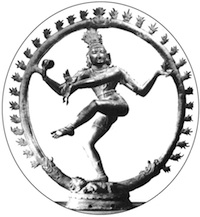
To many people, the words psychedelic and spiritual are dissonant on first hearing. Yet the use of psychoactive sacraments in shamanic and religious practices is found throughout history. The word entheogen, used to describe certain plants and chemicals when used for spiritual purposes, emphasizes this long-established relationship. Following is a survey of the most historically prominent and widely used entheogens.
PEYOTE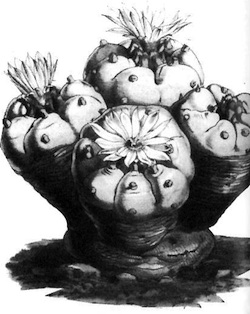 The peyote cactus, which has been used in Mesoamerica for at least 2,000 years, is still used sacramentally by the Huichol Indians of Mexico. Their ceremonies are said to closely resemble the pre-Columbian Mexican rites, largely unchanged by missionary influence.
The peyote cactus, which has been used in Mesoamerica for at least 2,000 years, is still used sacramentally by the Huichol Indians of Mexico. Their ceremonies are said to closely resemble the pre-Columbian Mexican rites, largely unchanged by missionary influence.
The peyote practices of Mexico began diffusing north into several of the native tribes in the United States during the latter part of the 1800s. The North American peyote ceremony, as described around the turn of the century, is “essentially different from that in Mexico (though having some basic similarities); a ceremony essentially Indian, but not of any particular tribe; a ceremony having overtones of Christianity, but so different from all Christian sects that it would provoke them all to do their best to eradicate it” (from Peyote Religion: A History, by Omer C. Stewart).
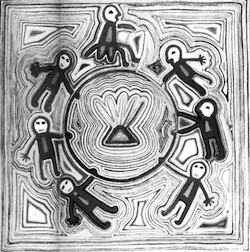 From the start, numerous contradictory government actions have supported and denied Native American use of peyote. Finally, in 1994, the U.S. government enacted the American Indian Religious Freedom Act Amendments, providing consistent protection across all fifty states for the traditional ceremonial use of peyote by American Indians.
From the start, numerous contradictory government actions have supported and denied Native American use of peyote. Finally, in 1994, the U.S. government enacted the American Indian Religious Freedom Act Amendments, providing consistent protection across all fifty states for the traditional ceremonial use of peyote by American Indians.
In its report on the 1994 legislation, a U.S. House of Representatives committee reported that “peyote is not injurious,” and that the “spiritual and social support provided by the Native American Church [NAC] has been effective in combating the tragic effects of alcoholism among the Native American population.” Occasional factionalism notwithstanding, it appears that the NAC has overall been a unifying and peace-promoting influence among the Native American tribes. Estimates of the number of peyote religion practitioners in the United States range from 250,000 to as many as 400,000.
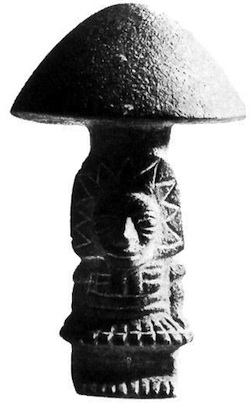 MUSHROOMS
MUSHROOMS
“Mushroom stone” artifacts found in Guatemala and southeastern Mexico date mushroom worship as far back as 1000 B.C.E. The Spanish conquerors reported psychedelic mushrooms to be of deep importance to indigenous religious life, and their use continues to the present in isolated areas. In 1955, R. Gordon Wasson rediscovered the use of psilocybin-containing mushrooms among indigenous peoples in Oaxaca, Mexico. His 1957 Life magazine report on the nighttime mushroom ceremony of curandera Maria Sabina sparked a revival of public interest in archaic and chemically mediated religious practices.
AYAHUASCA
The name ayahuasca (also Yagé, caapi) describes “teas” extracted from a wide range of Amazonian botanicals. The modern canonical form of ayahuasca is made from the vine Banisteriopsis caapi and a plant, Psychotria viridis, containing the potent psychedelic DMT. These entheogenic preparations are thought to be extremely ancient tools of Amazonian shamanism.
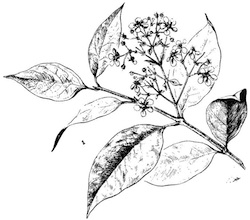 In the early part of this century, some Amazonian ayahuasca practitioners in Brazil migrated to the cities, where their old practices continued and sometimes blended with Western beliefs. Out of this grew new ayahuasca-using religions, most prominently the Santo Daime, founded around 1940, and the Uniao do Vegetal (UDV), founded in 1961. Congregations drink the tea during services usually held twice a month and on special occasions.
In the early part of this century, some Amazonian ayahuasca practitioners in Brazil migrated to the cities, where their old practices continued and sometimes blended with Western beliefs. Out of this grew new ayahuasca-using religions, most prominently the Santo Daime, founded around 1940, and the Uniao do Vegetal (UDV), founded in 1961. Congregations drink the tea during services usually held twice a month and on special occasions.
UDV services, which combine contemplation, music, and instructive discourse, run about four hours. Santo Daime services feature ritual music and dance, and often last all night. Each group has congregations in several countries in the
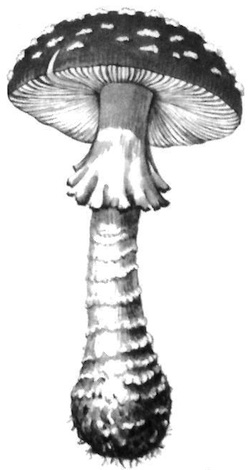 Americas, Europe, and Asia. The Brazilian government granted legal permission, provisionally in 1986 and permanently in 1992, for the religious use of ayahuasca and its constituent plants.
Americas, Europe, and Asia. The Brazilian government granted legal permission, provisionally in 1986 and permanently in 1992, for the religious use of ayahuasca and its constituent plants.
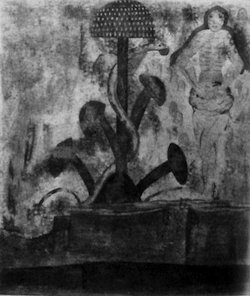 SOMA
SOMA
One of the oldest texts known, the Sanskrit Rig Veda, praises a mind-altering substance called soma. Of its 1,028 hymns, some 120 are devoted to extolling the virtues of soma and soma preparations; still more positive references are scattered throughout the other hymns. The identity of this revered plant was lost thousands of years ago. In 1968, Wasson published his thesis that soma is actually the psychoactive mushroom Amanita muscaria. Although other scholars have proposed alternative psychoactive plants as candidates for the forgotten soma, the key point remains that an entheogen was central to a seminal Eurasian religion.
KEYKEON
Wasson later turned his attention to the Eleusinian mystery rites performed annually near Athens for nearly 2,000 years. Research conducted by Wasson, chemist Albert Hofmann, and classical-era ethnobotanist Carl A. P. Ruck brought to light convincing evidence that the ritual that culminated in the once-in-a-lifetime initiation featured an entheogenic preparation, keykeon, containing substances related to LSD. In 395 C.E., the sanctuary at Eleusis was destroyed by forces intent upon suppressing the rites. Thus was this mystery religion, which offered direct experience of the sacred to each initiate, lost to future generations.
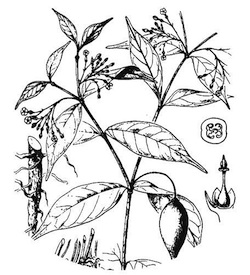 IBOGA
IBOGA
Centered in the West African Republic of Gabon, a 150-year-old syncretic Christian religion called Bwiti is thriving. A Bwiti initiate takes the central sacrament, the powdered root bark of Tabernanthe iboga, in massive doses during a three-day initiatory session. Enough of the predominant chemical, ibogaine, is ingested to ensure an ecstatic dream state likened to a near-death experience, beatific vision, and subsequent rebirth. Thereafter, Bwiti congregants take the iboga powder in smaller doses during night worship sessions held at intervals varying from weekly to quarterly. These ngoze ceremonies are designed to achieve a shared sense of “one heart only,” a mental state of goodwill and empathic understanding of others.
 Colonial missionaries attempted to suppress Bwiti, particularly between 1920 and 1940, destroying temples and murdering religious leaders. But when Gabon became an independent republic in 1958, a Bwitist became its first president, giving the Bwiti nearly the status of a state religion. The practice is now extending into other West African countries, where it is regarded as a helpful unifying influence.
Colonial missionaries attempted to suppress Bwiti, particularly between 1920 and 1940, destroying temples and murdering religious leaders. But when Gabon became an independent republic in 1958, a Bwitist became its first president, giving the Bwiti nearly the status of a state religion. The practice is now extending into other West African countries, where it is regarded as a helpful unifying influence.
CANNABIS
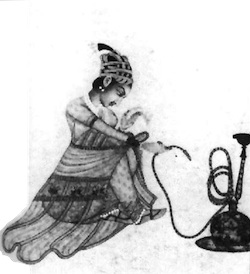 Cannabis (hemp, marijuana) is one of the oldest and most widely cultivated plants, valued in many cultures as medicine, food, fiber, and sacrament. It is said to have been used as an adjunct to prayer in ancient Taoist, Vedic, and Sufi practices, among others. Cannabis is most often regarded as a recreational drug; however, formal sacred use continues in certain communities, including those of Coptic, Rastafarian, and Hindu traditions. It is reported that more Americans are current users of cannabis than of all other illegal drugs combined. Its common use often defies neat classification as recreational, medicinal, or spiritual/entheogenic.
Cannabis (hemp, marijuana) is one of the oldest and most widely cultivated plants, valued in many cultures as medicine, food, fiber, and sacrament. It is said to have been used as an adjunct to prayer in ancient Taoist, Vedic, and Sufi practices, among others. Cannabis is most often regarded as a recreational drug; however, formal sacred use continues in certain communities, including those of Coptic, Rastafarian, and Hindu traditions. It is reported that more Americans are current users of cannabis than of all other illegal drugs combined. Its common use often defies neat classification as recreational, medicinal, or spiritual/entheogenic.
LSD
In 1943, the Swiss chemist Albert Hofmann discovered the psychoactivity of LSD. At first known only as an experimental psychiatric drug, LSD broke out of the medical profession and into a population of avid seekers and experimenters in the early 1960s. Accelerated by the ease of distribution and the low cost of LSD, potent chemical means for facilitating profound alterations of consciousness became available to a dramatically increasing number of people throughout the 1960s.
Most people who took LSD did so completely independent of any traditional cultural or religious context, although there were attempts to establish such contexts, with some explicitly instituted as “religions.” The difficulty of creating a new psychedelic religion became evident to Lisa Bieberman, who for two years published a newsletter to chronicle groups such as the League for Spiritual Discovery and the Neo-American Church. Reviewing this record, she wrote in 1967:
The collected back issues are a catalog of frauds and failures. . . . Most of the psychedelic projects I reported have flopped, even though the more obvious losers were screened out before printing. Those that remain are a caricature of the psychedelic vision, a mockery of the idealism of youth. [New Republic, Aug. 1967]
Still, the impact of LSD is not to be underestimated. Some contexts of ritual use—for example, Grateful Dead concerts—have endured. And a well-known Zen monk in Europe said recently that nearly all the new students who come to his school do so after taking a consciousness-altering drug, usually LSD.
 MDMA
MDMA
The unique psychotropic properties of methylenedioxymethamphetamine (MDMA, or ecstasy), described as more empathogenic and “heart-opening” than psychedelic, were discovered in the mid-1960s. In the late 1970s, an expanding community of psychologists and psychiatrists in the United States and Europe quietly began using MDMA in psychotherapy. The use of MDMA later emerged in dance clubs and other uncontrolled settings, attracting attention that resulted in its being made illegal in the U.S. in 1985.
Though still illegal, MDMA is probably the most commonly used drug at “raves”: all-night ecstatic dance events now found throughout much of the world. Many rave-goers and a few theologians have noted the fundamentally spiritual nature of this kind of ecstatic celebration. Some religious leaders have reported, usually anonymously, that they find MDMA to be a powerful adjunct to prayer and meditation. Unlike many of the other entheogens, the neurological safety of MDMA is still in question.
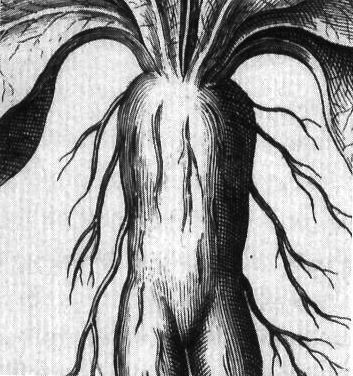 The historical and contemporary practices surveyed here demonstrate the spiritual significance of entheogens, and indicate that at least some of them can be used with reasonable safety. Religious practices with entheogenic sacraments remain illegal in most countries due to comprehensive bans on hallucinogenic plants and chemicals. However, a few countries, including the United States, do accommodate certain entheogen practices, though here the race of the participants as well as the religious tradition behind the practice are restricted. A genuine respect for religious freedom as guaranteed by the United Nations Universal Declaration of Human Rights and the U.S. Constitution would seem to require that such accommodations be adopted universally for the traditional plant entheogens (and other substances of comparable safety), that is, without regard to race or creed.
The historical and contemporary practices surveyed here demonstrate the spiritual significance of entheogens, and indicate that at least some of them can be used with reasonable safety. Religious practices with entheogenic sacraments remain illegal in most countries due to comprehensive bans on hallucinogenic plants and chemicals. However, a few countries, including the United States, do accommodate certain entheogen practices, though here the race of the participants as well as the religious tradition behind the practice are restricted. A genuine respect for religious freedom as guaranteed by the United Nations Universal Declaration of Human Rights and the U.S. Constitution would seem to require that such accommodations be adopted universally for the traditional plant entheogens (and other substances of comparable safety), that is, without regard to race or creed.
Well-crafted policies and practices would support the anti-drug-abuse objectives of the current drug laws, minimize the risks inherent in profound spiritual experience, and limit the potential for abuse by individuals and organizations that offer such experience. If this can be accomplished, spiritual communities and individuals will be free to decide for themselves the proper role of entheogens, and to evolve beneficial contexts for their use.
Thank you for subscribing to Tricycle! As a nonprofit, we depend on readers like you to keep Buddhist teachings and practices widely available.